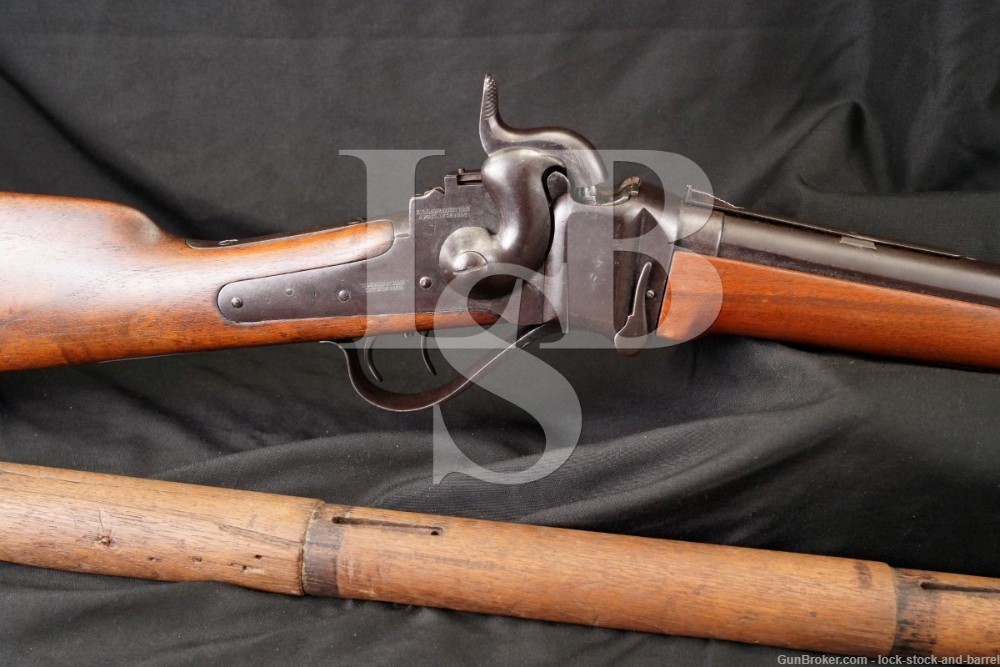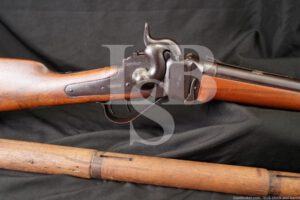
Civil War-era Sharps New Model 1859 Military Rifle .52 Percussion Antique
SOLD FOR: $4031
LSB#: 220928KC023
Make: Sharps Rifle Mfg. Co. of Hartford Connecticut
Model: New Model 1859 Military Rifle
Serial#: 55818
Year of Manufacture: Circa 1859-1862, Antique
Caliber: .52 Caliber
Action Type: Percussion-Ignition Single-Shot Lever-Actuated Falling Block Rifle
Markings: The top of the barrel is marked “SHARPS RIFLE / MANUFG. CO / HARTFORD CONN.” The left side of the frame is marked “C. SHARPS’ PAT. / SEPT. 12TH 1846”. The top tang is marked with the serial number. The right side of the frame is marked “R.S. LAWRENCE PAT. / APRIL 12TH 1859” and “C. SHARPS PAT. / OCT. 5TH 1852.” The left side of the wrist has a largely faded cartouche.
Barrel Length: 30”
Sights/ Optics: The front sight is a fixed brass blade. The rear sight is a dovetailed V-notch leaf over an elevator.
Stock Configuration & Condition/ Grip: The stock is two-piece wood featuring an aftermarket forend with a nose-cap secured with an after-market screw, a total of three barrel bands secured by springs (the center barrel band has a fixed sling swivel) and a retaining screw by the receiver; the refinished butt-stock has a straight wrist with a lock-plate on the right side, a straight comb, a metal patch-box, a provision for a sling swivel on the belly, a hole slightly ahead of the toe and a metal butt-plate. The gun comes with an additional forend that appears to have been refinished. There are scattered light handling marks, nicks and scuffs. Notably, the attached forend has a crack at the bottom that extends from behind the screw to the rear barrel band and a moderate scratch on the lower right portion. There are two moderate cracks on the left and right sides of the butt-stock that originate at the plate. The additional forend has a moderate chip at the rear and two heavy cracks that extend from the chip. The LOP is 13.5 and 13 inches from the triggers to the rear of the butt-plate. The butt-plate is coated in erosion. Overall, the attached stocks are in good condition and the additional forend is in Fair condition.
Type of Finish: Blue and Case
Finish Originality: Original
Bore Condition: The bore is dark with sharp rifling. There is scattered light-moderate erosion concentrated in the grooves. Most antique firearms have bores that will show erosion. This is not only due to age but to the use of black powder. When fired, black powder reacts corrosively. NRA Antique Firearm Conditions Standards are quite lenient for bores. In some cases the NRA standards disregarded the bore’s condition for collectors firearms.
Overall Condition: The rifle has no surviving metal finish. The gun is coated in light-moderate oxidation and has taken a deep patina color. There are scattered light handling marks, nicks and scuffs. Notably, the breech-block is coated in pitting, there is light wear along the leading edges and a circular patch repair just ahead of the rear sight. The markings remain mostly clear. The screwheads are tooled but serviceable. Overall, the gun is in Very Good condition as an Antique.
Mechanics: The action engages correctly. We have not fired this rifle. As with all used firearms, a thorough cleaning may be necessary to meet your maintenance requirements.
Box Paperwork and Accessories: There is an additional forend described above.
Our Assessment: Christian Sharps was a weapons designer who was born in 1810. He worked at Harpers Ferry early in his career and was impressed by John H. Hall’s breech-loaded rifle (the first American breech-loader which was originally built with a flint-lock system) which would inspire Sharps to develop his own breech-loader. His breech-loaded design was patented in 1848 and the first units entered production in 1850. The following year Sharps Rifle Manufacturing Company was formed, Christian Sharps served as a technical advisor to his namesake business receiving a royalty on every unit that was sold. Despite being named after him, Sharps left his namesake company in 1853 and formed a new company C. Sharps & Co. where he remained until the Civil War broke out. In 1862, as a consequence of the Civil War, Sharps partnered with William Hankins to form Sharps & Hankins with most of the company’s production dedicated to military contracts. After the war Sharps continued to work until 1874 when he succumbed to illness.
The Sharps rifle would be put to use in Kansas during the 1850s when a series of violent clashes erupted between abolitionists and pro-slavery settlers. The rifle was popular with the abolitionists and nicknamed the “Beecher’s Bible” after prominent abolitionist Henry Ward Beecher. When the Civil War broke out both the Sharps Rifle and a carbine variant were sold to the Federal Government and issued to a number of Army and Navy units. The carbine was particularly popular, with more Sharps carbines manufactured than any other (the next two most widely manufactured were the Spencer and Burnside). They would see widespread use throughout the conflict.
This particular specimen is a New Model 1859 Military Rifle produced by the Sharps Rifle Mfg. Co. between 1859-1862 (well after Christian Sharps left the firm). These rifles were famously used by Colonel Hiram Berdan’s sharpshooters during the conflict (Berdan was issued 2,000 Sharps which fell in the serial range of 36000-57000; we see no indication that this gun, serial 55818, was used by the elite unit). The gun has double-set triggers and the percussion ignition system that was used during the Civil War, despite this the gun has some alterations including an aftermarket rear sight, replacement forend and refinished stock. The gun has some wear, with some cracks on the stocks and oxidation on the metal parts but the action still engages correctly. This gun should make a wonderful addition to a historical firearms collection. Good luck on your bid!

